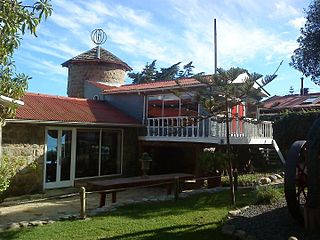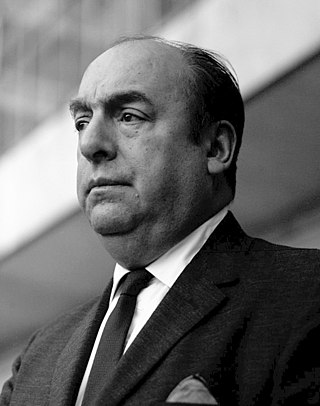This is a list of museums in Chile.
This is a list of museums in Chile.

Casa de Isla Negra was one of Pablo Neruda's three houses in Chile. It is located at Isla Negra, a coastal area of El Quisco commune, located about 45 km south of Valparaíso and 96 km west of Santiago. It was his favourite house and where he and his third wife, Matilde Urrutia, spent the majority of their time in Chile. Neruda, a lover of the sea and all things maritime, built the home to resemble a ship with low ceilings, creaking wood floors and narrow passageways. A passionate collector, every room has a different collection of bottles, ship figureheads, maps, ships in bottles, and an impressive array of shells, which are located in their own "Under the Sea" room.

Isla Negra is a coastal area in El Quisco commune in central Chile, some 45 km south of Valparaiso and 96 km west of Santiago.

Pablo Neruda was a Chilean poet-diplomat and politician who won the 1971 Nobel Prize in Literature. Neruda became known as a poet when he was 13 years old and wrote in a variety of styles, including surrealist poems, historical epics, political manifestos, a prose autobiography, and passionate love poems such as the ones in his collection Twenty Love Poems and a Song of Despair (1924).

Darío Escobar is a Guatemalan artist.

El Quisco is a Chilean city and commune in San Antonio Province, Valparaíso Region. Located in the country's central coast, it serves as a popular summer resort for the population of Santiago and forms part of the Coast of Poets, a cultural space named after four world-renowned Chilean poets: Pablo Neruda, Vicente Huidobro, Violeta Parra and Nicanor Parra. El Quisco is home to La Casa de Isla Negra, the former house of Chilean poet Pablo Neruda, which is now a museum and Neruda's burial site.

Manuel Espinosa was an Argentinian painter.
IGNACIO ORTIZ CEDEÑO

Mauricio García Vega is a Mexican painter whose work has been recognized by various awards and membership in the Salón de la Plástica Mexicana. His work is mostly focused on urban landscapes, often with dark themes and a chaotic feel. He works both alone and with his brother Antonio García Vega. He lives and works in the Mexico City suburb of Ciudad Nezahualcóyotl.
Julio Mario Luqui-Lagleyze is an Argentine historian. Born in Buenos Aires in 1959 received a degree in History in 1982. He specializes in Hispano-American Military and Naval History and Military Museology. He is currently studying for his PhD in History at the Universidad Católica Argentina.

The Coast of Poets is a cultural space in the Valparaíso Region of Chile, named for four world-renowned Chilean poets.

Samy Mauricio Benmayor Benmayor is a Chilean painter who formed part of the Generation of '80 movement.
Carlos Eduardo Maturana Piña, better known by his artistic pseudonym Bororo, is Chilean artist born in Santiago, Chile, on November 10, 1953. Along with Samy Benmayor, Omar Gatica, Matías Pinto D'Aguiar and Ismael Frigerio among others, he formed part of Chilean art’s 80s Generation. Bororo was his childhood nickname.
Leonel Maciel is a Mexican artist, member of the Salón de la Plástica Mexicana, from the coast of the state of Guerrero. Although from a rural area and farming family, he studied art at the Escuela Nacional de Pintura, Escultura y Grabado "La Esmeralda" and has traveled extensively in Europe and Asia, which has influenced his work. His art has changed styles from generally contains multiple elements and saturated colors.
Ximena Zomosa is a visual artist and curator who works in contemporary art and conceptual art, whose work demonstrates — from the perspective of gender — a discourse that is fundamentally feminine. She acted in a managerial and curatorial capacity at the Balmaceda Youth Art Gallery, a space for art by emerging Chilean artists.

The Casa Central de la Universidad de Chile, also known as Palacio de la Universidad de Chile, is the main building for the Universidad de Chile, and is located at 1058 Alameda Libertador Bernardo O'Higgins, in Santiago, Chile. The building dates from 1872, and currently houses the rectorate, rooms used for ceremonial events and the university's Andrés Bello Archives. It was declared a National Monument of Chile in 1974.

Óscar Roberto Gacitúa González is a Chilean painter.